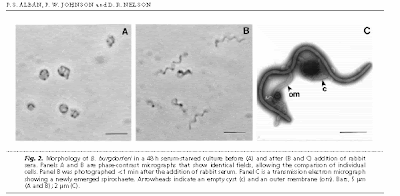Graeme Singleton, 26 Nov, 2009 quoted direct from the Coffs Coast Independent
 TICKED OFF ... Natalie Young (standing) said she was often covered with ticks during her working day as a conservation officer, but never realised they could infect her with Lyme Disease. She now wants others who work in the bush and on farms to be aware of the dangers posed by ticks.
TICKED OFF ... Natalie Young (standing) said she was often covered with ticks during her working day as a conservation officer, but never realised they could infect her with Lyme Disease. She now wants others who work in the bush and on farms to be aware of the dangers posed by ticks.NATALIE Young knows far more about Lyme Disease than she ever wanted to.
The Glenreagh mum was diagnosed with the chronic tick-borne infection earlier this year, but not before it had taken a stronghold in her body and turned her life upside down.
“You can’t believe what its like to live with Lyme Disease,” Natalie said.
“I’m forever tired and in constant pain. My muscles and nerves ache and I get migraines all the time.
“I wouldn’t wish it on anybody.”
Natalie first went to her doctor in January this year.
The 33-year-old was employed by the National Parks and Wildlife Service as a conservation officer, but now doubts whether she will ever work again.
“My hands and knees were aching, I was constantly fatigued, I had breathing difficulties because my throat was in spasms,” Natalie said. “One day my arm actually seized up for a couple of hours.”
Initially Natalie thought her illness was related to the Ross River Fever condition she’d earlier been diagnosed with, but after that along with heart disease, lupus, chronic arthritis, fibromyalgia and even multiple schlerosis had been ruled out, she pursued the possibility that ticks could have been responsible.
“I remember different times when I came home from working in the bush covered in ticks,” Natalie said.
“Once I had more than 100 ticks on me. I had to get a friend to pull them out of my back.”
Her diagnosis with Lyme disease came in late March after she had consulted a GP in Laurieton and had a series of blood tests.
They returned mixed results before positive antibody results from laboratories in Germany, The Untied States and Sydney.
Compounding the many challenges she faced was the fact that health authorities do not acknowledge the presence of Lyme Disease in Australia.
“It is a big problem in America and elsewhere in the world, but apparently not here,” Natalie’s husband Steve said.
“The authorities are only too happy to warn about the dangers posed by ticks to pets and livestock, but for some reason they won’t accept Lyme Disease occurs here.
Steve said if health authorities acknowledged that Lyme Disease exists in Australia, Natalie may have been diagnosed sooner.
“As with most diseases, early diagnosis enables more effective treatment,” Steve said.
”It has devastated her.
“I doubt whether she’ll ever be able to work again. I can now only hope that she can escape the constant pain she is in.”
Natalie is surprisingly more upbeat.
“My doctor is confident that while I will probably never fully recover, it shouldn’t get any worse for me.” she said.
“That I can live with.”






